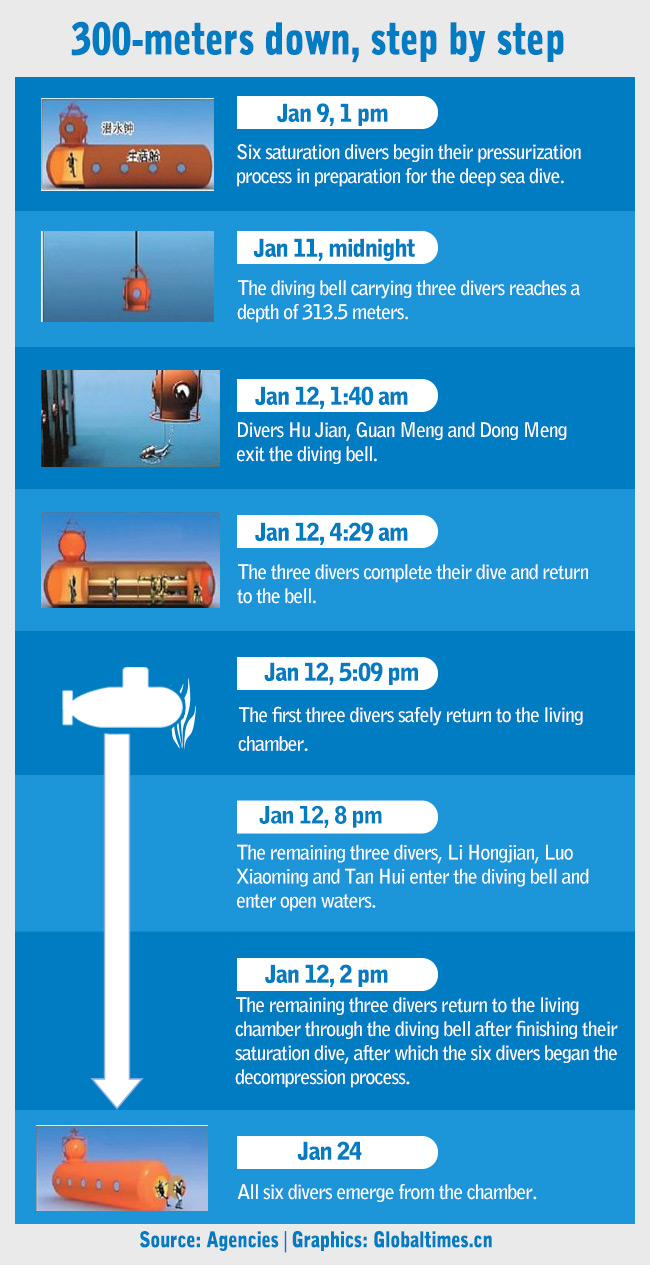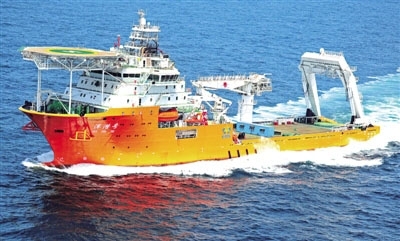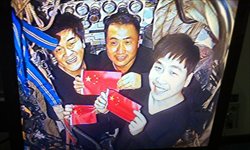HOME >> CHINA
In-depth look at China's first 300-meter saturation dive
Source:Globaltimes.cn Published: 2014-1-13 16:49:00
| Latest News |
| Chinese divers hit 300 meters China succeeded in its first 300-meter saturation dive on Sunday morning as three divers returned safe and sound from deep water to their ship. | |
| China succeeds in first-time 300-meter saturation diving China recruits six aquanaut cadets for deep-sea exploration | |
| Procedures |

| Illustration |
Saturation diver's life
 Breathing
BreathingDivers breathe a mix of helium and oxygen, which raises the pitch of their voice.
 Pressure
PressureUnder 300-meters of water, divers are exposed to atmospheric pressure 31 times stronger than that on the surface.
 Eat
EatFood is prepared by a dedicated chef and delivered through a round opening in the living chamber. Divers are restricted to a soft-food diet, as chewing can damage their teeth. Divers are kept away from foods that cause flatulence, such as soybeans.
 Sleep
SleepThere are six bunk beds in the 11-meter-long living chamber. While divers require over 12 hours of rest a day, they are unable to turn off the cabin lights.
 Defecation
DefecationDivers report to monitors on the ground before and after using toilet and taking a shower. Divers are only allowed to flush the toilet and turn off the water release valve after receiving monitor approval. The waste is then sent through another system of valves and deposited in a storage tank.
 Clothing and gear
Clothing and gearAs temperatures hover between 38 C to 40 C, divers wear loose-fitting cotton clothing. While diving, hot water suits, or special suits that circulate hot water through an intricate network of webbing, are required to maintain body temperatures.
Source: Beijing News
| Development |
| To date, eight countries, namely Britain, the US, Switzerland, Norway, France, Germany, Japan, Russia, have succeeded in 400-meter saturation dives. | |
| In 1957 |
Humans were first found to be able to handle prolonged exposure to different breathing gases and high pressure environments through American scientist George F. Bond's Genesis project. |
| In 1962 |
The American Navy's "Man-in-the-Sea" Program conducted the first saturation dive in the world. |
| In 1988 |
French divers reached a depth of 534 meters using the saturation diving technique. |
| China has made impressive achievements in marine research in recent years. | |
| In 1989 |
The Chinese navy conducted its own experiments, setting a dive record for Asian countries at the time. |
| In 2006 |
A locally developed saturation dive system took divers to 103.5 meters under the South China Sea on a rescue mission in November 2006. |
| In 2007 |
Construction of the 300-meter saturation dive system began in November 2007. |
| In 2012 |
The Jiaolong, China's most advanced manned submersible, achieved a record dive depth of over 7,000 meters. |
| In 2014 |
China succeeded in its first 300-metre saturation diving on January 12 as three divers returned safe and sound from deep water to the living chamber on the ship. |
| Source: Agencies | |
| Significance |
| Related Reports |
In pictures: China succeeds in first 300-meter saturation dive
China succeeds in first-time 300-meter saturation diving
China starts first saturation diving experiment
China starts first deep-water saturation dive test
Posted in: Society

